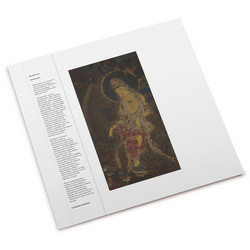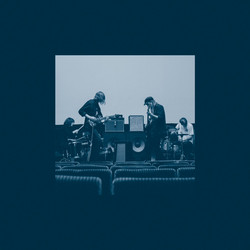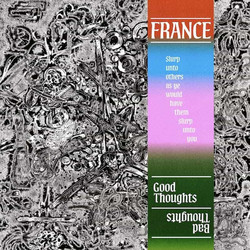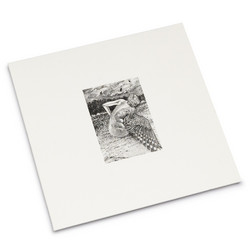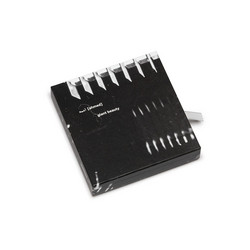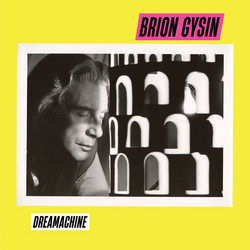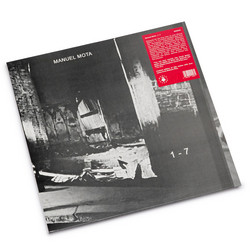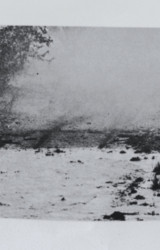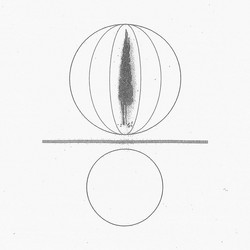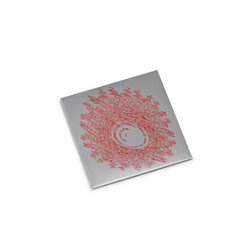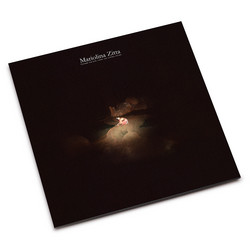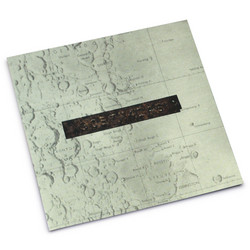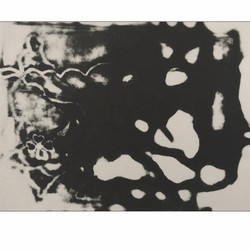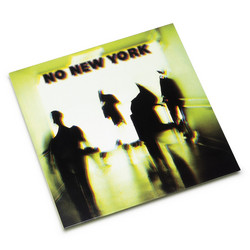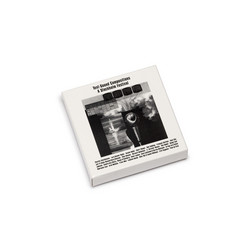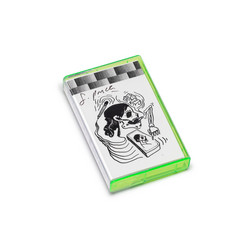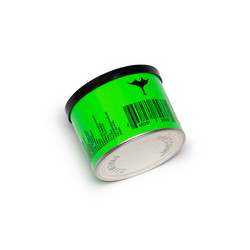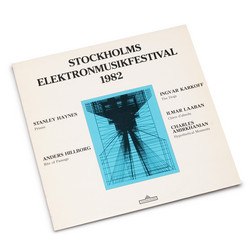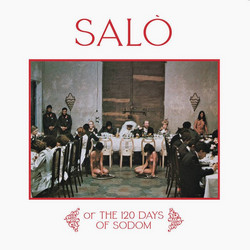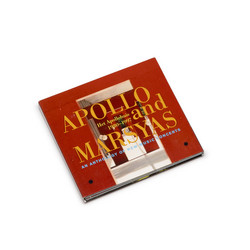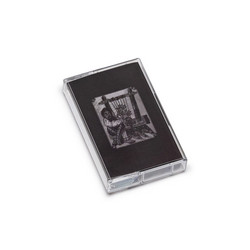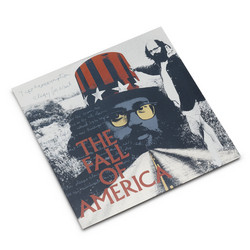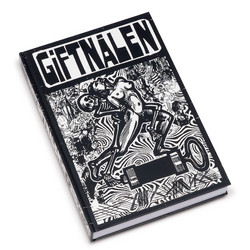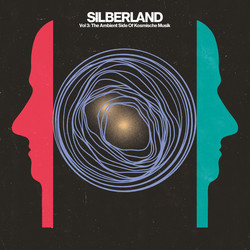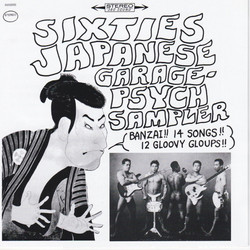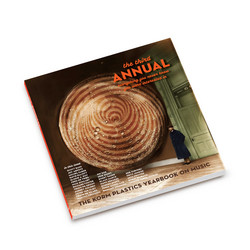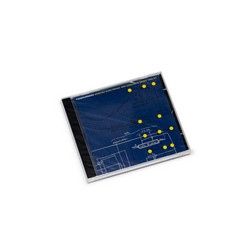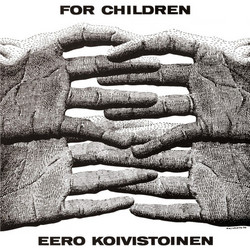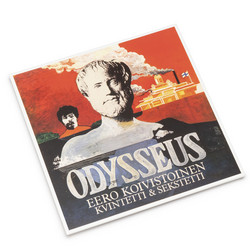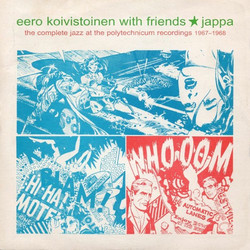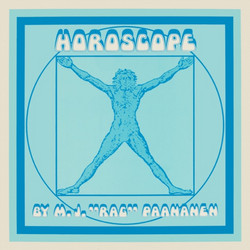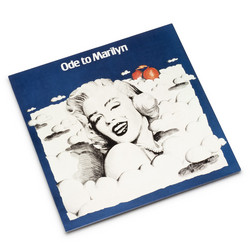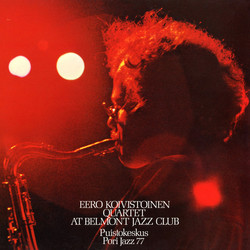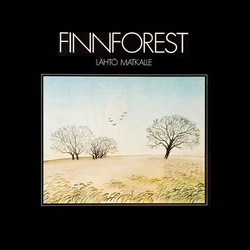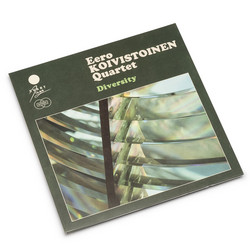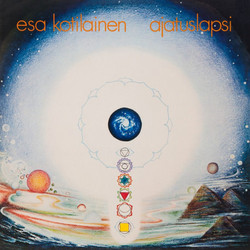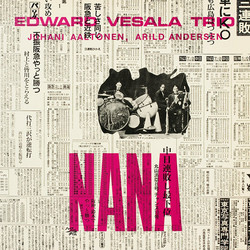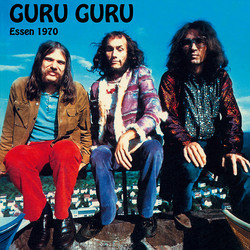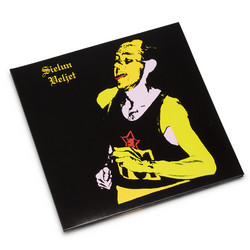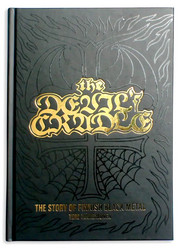Various
Eteenpäin! Vorwärts!Forward!Antauen! 1966-70 (6LP Box)
A 6xLP box comprising the entire discography of Eteenpäin! Records, the first Finnish record label and also the first to release music from outside the mainstream, including experimental and totally weird styles. Includes tracks by legendary artistst such as Sperm, M.A. Numminen, J.O. Mallander, Rauli Somerjoki, Markus Allan, Pepe Willberg, Tommi Parko, Baby Grandmothers, Nalle Puh Big Band and many others.
The classic Eteenpäin! Period consists of only 14 seven inch records (one of them in Esperanto) and one LP. These releases contained musical interpretations of educational texts, fragile recorder folk, chaotic home-recorded free jazz, German lied works performed with a wavering voice, mocking politico-philosophical ditties performed off the beat, a recording of the vote count of a national election and experimental noise created with the human voice and a broken electric guitar. The amateurishness of some of the performances was unheard of at the time, and it wasn’t until the birth of punk, a decade later, that similarly talented musicians released records. This was music that was clearly meant to appeal to either very discerning or very wide tastes.
Eteenpäin! records are also an integral part of the history of Finnish avant-garde and underground culture. Public scandals, police interventions and censorship are a bigger part of the Eteenpäin story than any other record label at the time, although many of these incidents were caused by the performances of the label’s artists than the actual label itself.
The label was started in the spring of 1966 by ethnomusicologist and journalist Pekka Gronow and singer-artist M.A. Numminen. Numminen needed a channel for his creative work, and Gronow sought first hand experience for his thesis on the record industry.
The records:
Numminen’s debut EP (see album 2A), recorded in May 1966, featured Hevoset ja minä, a tastefully zoophilic short story by Peter von Bah, a linguistic aphorism by Numminen and two texts by sociologist Erik Allardt set to music, dealing with alienation and anger. Everything was done on a shoestring: friends who were musicians offered to work for free, recording was done using a simple portable tape recorded and even record sleeves were glued together by hand. Later the duo often made cost-free recordings using the studios of the Finnish Broadcasting Corporation or with the pro-grade equipment at a concert hall owned by Finland’s communist party. ”Sex-EP”, released in August, contained songs whose lyrics were lifted from sex manuals and legal regulations regarding pornography. Guest vocalist was Rauli ”Badding” Somerjoki, later to become a legend of Finnish rock music. The songs had already caused an uproar in Jyväskylä at a well respected annual cultural event. In addition the record has a composition by Finland’s tango master Unto Mononen, Naiseni kanssa eduskuntatalon puistossa. Regardless of this song’s cleanness the entire record was banned on Finnish radio. Musician friends and intelligentsia gave a warm reception to these curious records. Slowly Numminen managed to gain more acceptance for his art from a wider spectrum of people, many of which considered him a parody act. This interpretation was supported by Numminen’s squeaking, shrieking manner of singing. By the end of summer 1966 Hevoset ja minä managed to briefly make it to the list of hit songs picked by national radio’s youth jury. This caused more demand, and the debut EP started to make some actual profit. One can’t, however, call the next EP profitable. It contained texts by Ludwig Wittgenstein set to pop jazz music, sung in English. Apparently Wittgenstein Pop (see album 2B) aroused interest in American philosophical circles, but this did not result in the international breakthrough Numminen had hoped for. Numminen was conscripted in December 1966, and no new Eteenpäin! records were released during those months. In late 1967 it was time for Numminen’s first album, In Memoriam (album 1), on which a lot of Numminen’s friends guested, with quite a few popular musicians among them. Nobody was given any pay. The hit song of the album was Jenkka hevosen puhdistamisesta, also released as a single. The song parodied military directives for handling a horse, and it was composed at the request of the army’s public relations officer. In addition to Numminen’s own compositions the album had three songs by Unto Mononen. Lyricists included poets Anselm Hollo, Markku Into and Marja-Leena Mikkola. Next to more melodic and even schlager-like tracks the album featured avant-gardistic home recordings from the early sixties (Eleitä kolmelle röyhtäilijälle and Juhannusblues, a Mingus-influenced growlfest). In March 1968 Numminen irritated tv viewers by singing and shrieking Franz Schubert’s Ständchen with his highly original voice. Numminen, a fan of the German composer, got the idea to make an entire EP of Schubert’s German lied works (see album 3A). Next autumn it was time for an even more cosmopolitan project when Finland’s Esperanto Union asked Numminen to provide a musical version of the Universal Declaration of Human Rights in Esperanto. Numminen had already performed this number in Finnish on a record published by the student board of the Helsinki university. Päivi Paunu reprised her role as lead vocalist on the Esperanto version as well, as Numminen though her beautiful voice would serve the purpose better than his own. (See album 3A) The most remarkable items in Eteenpäin!’s 1968 output no longer were Numminen own works but many intriguing things of the current countercultural status quo to which the label gave a voice. The idea was to use the label as a base which people who wanted to have their music released could use. The label would offer their name and expertise, the artist would handle expenses and also receive possible profits. For example, the debut record by the legendary underground act The Sperm was produced this way and released in early 1968. Recording session took place in Pekka Airaksinen’s cottage with a single Tandberg tape recorder, with the help of a tape delay and feedback. Airaksinen himself plays a prepared, unorthodoxically tuned Teisco guitar with a broken neck (see album 4B). To cut expenses the record was released as a one-sided 33 rpm ”mini-LP” with a psychedelic drawing glued to the blank side. Labels were written by hand. The first foreign artist on Eteenpäin! was supposed to be John Fahey, whom Gronow had met through his North American contacts. Eteenpäin! wanted to release the guitarist’s version of Finlandia by Jean Sibelius (We Would Be Building) but there were copyright issues. Toivo Kärki, the production manager of the big record company Fazer allowed the release of Finlandia on his company’s sublabel Sävel. It is not known how the Sibelius estate reacted, but the copy in the record library of the Finnish Broadcasting Corporation is marked with a green square, which refers to restrictions regarding on-air play. (Fahey’s songs are not present on this compilation, as they were not available for licensing by the current rights holder. The songs were not part of the official Eteenpäin! canon and are easily available on Fahey’s records.) Another international name was the Swedish progressive rock band Baby Grandmothers, who recorded a single for Eteenpäin! while performing at an art event by Espoo’s polytechnic students in March 1968. In Sweden the band was not well known and had released no records. Regardless of problems related to illegal substances the band succeeded in recording two long, psychedelic tracks, for which there was no market in Finland at the time, however. (see album 4B) In the autumn of 1968 it was time for the ironic ready-made record by J.O.Mallander, an art critic and part of the Sperm collective. Material for the record was taken from two radio broadcasts from the vote count of Finnish presidential elections. In both of these elections the same man, Urho Kekkonen, was the winner. (See album 5A) Those Lovely Hula Hands was a charming acousting quintet, named after a Hawaiian song from the 1940s. Photography students Timo Aarniala and Meri Vennamo were in their early twenties, their little sisters Anne-Maj and Raisa and their friend Tuomas Korvenoja were 13-14 years old. Meri Vennamo described TLHH as a ”nature band”, who played for their own enjoyment and was always genuinely surprised if someone requested them to perform. Their EP, released in the autumn of 1968, consisted of instrumentals and songs based on short melodic themes, short improvised sound pieces recorded in the stairway and a dramatic piece of musical theatre, about the meeting of Tarzan and Jane Porter. (see album 4A) S. Albert Kivinen, assistent at the faculty of theoretical philosophy in Helsinki, mocked bourgeois science and the political right in texts set to schlager melodies, which he performed spectacularly out of sync with the backing orchestra. The vocalist and the musicians do not appear to care what the other does. The mini-LP was an Eteenpäin! Production, but at the request of the artist it was released under a fake label name Actum Philosophicum Fennicum in early 1969. (see album 3A) The Kivinen and Those Lovely Hula Hands material was originally recorded for the radio show Maanalaista menoa, done by Numminen and the Turku-based art collective Suomen Talvisota 1939-40 (see album 3B). The multi-artistic collective, influenced by beat poetry, American counter-culture magazines and the Yippie movement, were the Finnish counterculture powerhouse together with The Sperm. While working on the radio show, the group’s musical division found the time to record their own songs which were in the old twelve bar blues-rock format. These songs glorified the joys of illegal drugs and carnevalesque anarchism and opposed society. A few songs were also recorded in Swedish. Nuoren Voiman Liitto, a society of young culturally-minded people published five songs by Suomen Talvisota as part of their musical anthology, which was released in the spring of 1969 as a mini-LP. The record was published by NVL, but Numminen and Gronow from Eteenpäin! Were an integral part of the project behind the scenes. Vihreä valta is a light-hearted fighting song for the ”new force”, in which radicals grab baseball bats to chase away the stagnant old farts of Society. Due to its language the song was forbidden on the national radio. Talvisota-rock pokes fun of the war myth many Finns consider holy by turning Finland’s famous defensive warfare into a go-go carnival, which is joined by president Ryti, Soviet dictator Stalin, Finland’s marshall Mannerheim and the Soviet foreign minister Molotov. Kekkonen -rock takes aim at the current president: how would the president and rock’n’roll fit together? Mielitauti-rock makes human tragedies and lists of maladies into an irreverent bacchanalia. The humorous ”working class song” Tehtaan vahtimestarit is about rebellious doormen who poison their boss. In the yippie-influenced Liput liehuivat (presented here as an early radio version) anarchist rockers urinate over symbols of power in a men’s bathroom and a riotously high bunch of snow guerrillas votes a pig as the leader of the country. There also where three other groups on the NVL record (album 4A). Tiitta Sipponen & The Saturdists was a school group from Jyväskylä, whose somewhat stumbling Swan Lake gets an extra boost from Soosi ja Muusi’s ironic poetry reading. The reciters’ reference to a popular toothpaste brand resulted in this song, too, being forbidden on national radio. Soosi ja Muusi was a musico-political hit squad making fun of the stagnant and hypocritical art system. Their performances combined composed parts with cacophony, as their audience was invited to take part in the show with triangles, cymbals, drums and flutes. Their track A niin kuin Aaron is apparently a poke at Michael Aaron, a household name in piano studies at the time. Those Lovely Hula Hands plays a fragment from Bob Dylan’s I Shall Be Released. Their other track Oma nainen is a satire about a young student on the brink of sexual awakening. Very different kind of underground culture was represented by the recording debut by the trotskyite working class tradition expert Sulo Vakkari, which was most likely released in early 1969. It was the first of many releases of historical working class songs put together by Pekka Gronow in years to come. Pohjoisessa Pietarsaaren kaupungissa tells about acts of violence during Finland’s civil war in 1918. A couple of Finnish-American recordings by Otto Pyykönen and Hannes were added to round up the mini-LP. The last classic Eteenpäin! record was a wild free jazz record by percussionist Jouni Kesti and saxophonist Seppo I. Laine, which was released with the funding by the Academic Jazz Club in 1970. The songs Vallankumouksen analyysi and Punalippu aimed to apply the basic tenets of marxist dialectics. Laine’s incredible distorted sound was created by pushing the microphone deep inside his reed and also turning the tape recorder’s input volume up. (See album 5B) Numminen’s second LP Taisteluni appeared in 1970 funded by Love Records and with their labels, although it was still an Eteenpäin! Production. Most of the tracks had already been released on Eteenpäin! The most important previously unreleased track was Kaukana väijyy ystäviä, a pioneering electronic music experiment. The Sähkökvartetti (”Electric Quartet”) which squeals on the track was a collective electronic instrument operated by four people simultaneously, built by the most important instrument architect of Finland’s electronic avantgarde movement, Erkki Kurenniemi (see album 2B). During 1969 the label started slowly fading. Quitting as an option had been brought up since the year of the label’s inception. Gronow says the last releases were for such small audiences only that distributing them to shops was no longer sensible. Moving towards more professional status would’ve created more income options but also added obligatory responsibilities. Numminen, on the other hand, had more live shows than before, so he had less time to handle his record label magnate duties. In a small country such as Finland the supply of personal, special artists with no hopes for commercial success but eager to record was small. On the other hand the local record label scene had changed since the spring of 1966. Six months after the first Eteenpäin! session appeared Love Records, who released new domestic rock music and music by the leftist literary musical movement with a professional approach. Love Records showed that it was possible to be economically sound and still keep the adventurous and the curious side to the label output, although Love’s catalog all in all was somewhat more conservative than that of their minuscule predecessor. In 1970 Love Records was given permission to use the label Eteenpäin! as their own sublabel. The Love Records series featured some of the most uncommercial examples of political music. Numminen also joined the Love roster and became a commercial success. After Love’s bankruptcy Numminen resuscitated Eteenpäin! and used it to release his own works. Eteenpäin! documented an important slice of the cultural milieu of the late sixties in Finland. Its short ”golden age” is full of crucial Finnish talent – poets, composers, visual artists and general renaissance men. The label’s main focus were undoubtedly curiosities of all genres. ”We wanted to make way for music which didn’t exist in Finland earlier”, says Gronow, ”Us both wanted to have fun on the side, of course, we wouldn’t have released such strange records otherwise.” Without these records our view of Finnish music in the late sixties would be fatefully incomplete. It would look less nuanced and jagged, less curious and experimental. And a lot gloomier. With its multitude of genres and avantgardistic bent Eteenpäin! brings to mind the New York label ESP-Disk. The labels also shared the connection to Esperanto. However, when compared to Eteenpäin! records, many ESP-Disk records sound like mainstream music, and ESP-Disk was more professional – they even had an office. A common trait seemed to be the effort to minimise costs, as ESP has later been accused of skipping royalty payments. Eteenpäin! never even promised any. Eteenpäin! proved that one can operate in the field of experimental recordings without losing a fortune. One was able to release records for very small audiences. A decade after the end of their acive period Eteenpäin! had already inspired many followers. What was the image of the label for contemporary people, then? Their output received a surprisingly big amount of exposure in the media, even though the most active writers were the label owners themselves or people connected to them. In the tolerant, reform-spirited and antiauthoritarian cultural atmosphere – speaking most of all about students and the liberal intelligentsia – everyone felt interested about almost anything and it was easy for anything to get noticed. One still can’t escape the fact that even in the culturally radical circles a majority of the label’s artists were marginal. The most important underground group in Helsinki, The Sperm, gained a lot of notoriety in the media, but mostly with their sexually charged performances. Sperm, as well as Those Lovely Hula Hands, have only later received the stature they now hold. Suomen Talvisota 1939-40 was a decisively important influence to many a maker of Finnish rock (pioneers of the punk movement included) but their first EP received even less attention than the full lenght album on Love Records, the first pressing of which only sold 300 copies. The most lasting achievement of Eteenpäin! is undoubtedly making way for M.A. Numminen, who against all odds managed to rise from an extreme marginal position to almost a household name for all Finns. The last record of this collection consists of previously unreleased treasures from M.A. Numminen’s archives. The material includes Swedish and English language versions of his early songs (see album 6A). The ”aleatoric jazz band” The Orgiastic Nalle Puh Cultivators, better known as Nalle Puh Big Band (the group changed name due to endless typing errors) is a more or less fabled star in the pantheon of Finnish musical avant garde, but none of their recordings have been made available until now. Numminen and Gronow both were founding members. The idea was to apply the principle of randomness typical of the so called Happening art movement to jazz music. The band was to not have a ”conventional division by skill”. Skilled and novice musicians were seen equal, and only a couple of members could actually be considered a skilled musician anyway. The band’s unofficial recordings show that M.A. Numminen’s vocal talent was already fully developed before his first official recordings. (See album 6A). An important collaborator of Numminen, Tommi Parko did similar experiments as Pekka Airaksinen with his Tandberg tape recorder. Viiv and Täk utilise the machine’s delay and feedback effects. (See album 6B) Poli-blues is a recording of M.A. Numminen’s second public performance, which took place in October 1963 at an event by polytech students. The student magazine considered Numminen’s onomatopoetic blues sounds full of ”incredibly strong and original power”. The piano accompaniment, which followed the principle of randomness, the critic found ”thoroughly unconventional”. (See album 6B) The last track is Numminen’s bilingual telephone answering machine message from 1969.
